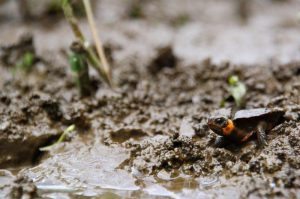CLC Temporarily Closed the Spencer Mt. River Access on June 29
June 27, 2012On the Bird Watch at Buffalo Creek
July 2, 2012 Davidson College’s Department of Biology and Catawba Lands Conservancy (CLC) are pleased to report preliminary survey results of a rare and federally threatened bog turtle population residing on a CLC preserve.
Davidson College’s Department of Biology and Catawba Lands Conservancy (CLC) are pleased to report preliminary survey results of a rare and federally threatened bog turtle population residing on a CLC preserve.
Bog turtles were first observed at the Gaston County preserve in 1991. With grant funding from Williams-Transco, researchers and students of the Davidson College Herpetology Laboratory (DCHL) have been studying the turtle population since 2006. CLC’s bog turtle population is one of only a few in the North Carolina Piedmont.
Surveys for bog turtles have been conducted regularly at this site and the numbers of turtles have declined substantially since the mid 1990s. In fact, since 2007, only a few turtles – between the ages of 20-35 – have been observed. However, in early June during a 24-day period of intensive searching, my team and I found 10 turtles. Two of them are juveniles: a one-year-old and a three-year-old. Seeing evidence of successful reproduction is certainly exciting and noteworthy news. 
Bog turtles are dependent on relatively rare and specialized wetland habitats such as bogs and fens. This, in conjunction with their small size and preference for wallowing in the mud, makes them really difficult to find. The turtles are individually marked, so we know each one’s history. With help from our dedicated DCHL volunteer James Green and students from Dr. Michael Dorcas’ Herpetology Laboratory class, we spent many hours searching over the past several weeks for the turtles. “It’s like searching for a needle in a haystack, but we’ll keep looking throughout the summer,” said Michael. “We know this group has successfully reproduced twice in the past three years, which is incredibly exciting!”
Searching for these turtles involves two different methods: trapping and probing. Small, harmless traps with shade covers are placed in likely travel corridors, and checked daily. We also use large sticks to probe the mud and vegetative clumps. Both methods are effective, and sometimes certain turtles are only found in traps while others are only found by probing the mud. Bog turtles are legally protected or regulated in all states were they are found. But in North Carolina, these regulations do not provide protection of their habitat. That’s why finding these turtles successfully reproducing on CLC’s permanently conserved property is so important. (For safety and protection of this rare and threatened wildlife species, CLC is withholding the name of the preserve).
Written by Jacquelyn Guzy
Biologist
Department of Biology, Davidson College
Bog Turtle (Glyptemys muhlenbergii) Facts:
- The bog turtle is the second smallest turtle in the world and is found in the eastern United States from New England to northern Georgia.
- Bog turtles hibernate in winter, often using the same mud burrows year after year.
- Each side of the head features a large orange blotch.
- Bog turtles mate in spring and nest in summer, with females typically laying a clutch of one to six eggs a year. Beyond nesting, there is no parental care. Hatchlings grow quickly but may not reach sexual maturity until they are 10 years old.
- Bog turtles have many natural predators, but the biggest threat to their survival is the fragile nature of their vanishing ecosystem. Human-induced stressors such as destruction of bog turtle habitat for urban and agricultural development and collection for the pet trade have led to federal protection of this species.
- Northern populations are federally listed as threatened, while southern populations are listed as threatened by similarity of appearance to northern populations. In North Carolina, this species is listed as threatened.
- The bog turtle is listed on Appendix I of the Convention on International Trade in Endangered Species (CITES), which means that international commercial trade in this species is prohibited.
